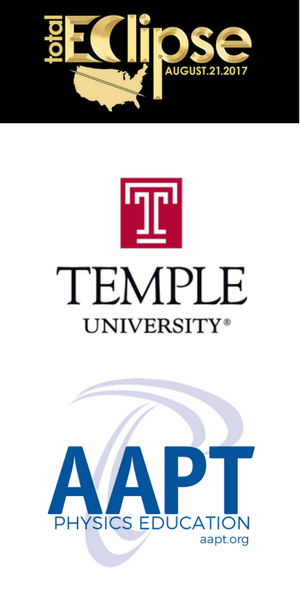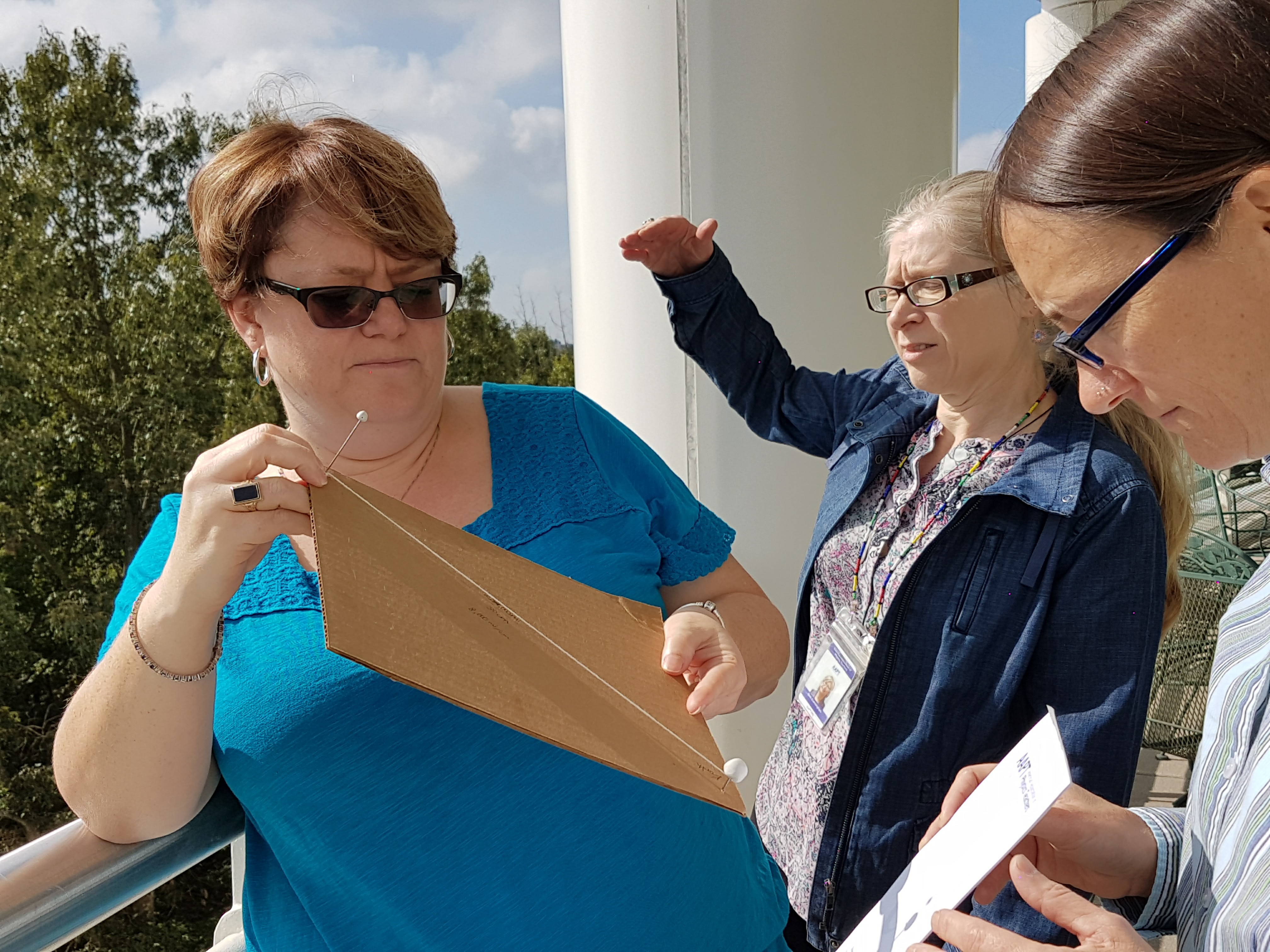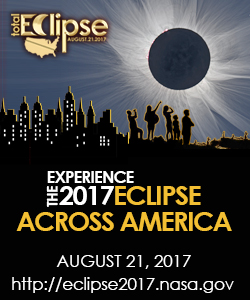Eclipse2017
Total Solar Eclipse 2017: Research-Based Teaching Resources
NASA Heliophysics Education Consortium
AAPT and Temple University are proud to be among the 27 partners in the NASA Heliophysics Education Consortium. This 5-year initiative from NASA's science directorate leads the development of research-based instructional materials for astrophysics taught in the context of introductory and upper division physics and astronomy courses, as well as K-12 teacher preparation.
The AAPT/Temple resource development team have created a number of products that are designed for use in formal classroom environments to help students understand Earth, Moon, and Sun relationships in the context of the 2017 Total Solar Eclipse. These resources are based upon common conceptual struggles students encounter with these topics and have been vetted by the team in their own classrooms. Register here for an upcoming webinar with the developers of these resources on Wednesday, March 22, at 8 PM ET.
AAPT and Temple University are proud to be among the 27 partners in the NASA Heliophysics Education Consortium. This 5-year initiative from NASA's science directorate leads the development of research-based instructional materials for astrophysics taught in the context of introductory and upper division physics and astronomy courses, as well as K-12 teacher preparation.
The AAPT/Temple resource development team have created a number of products that are designed for use in formal classroom environments to help students understand Earth, Moon, and Sun relationships in the context of the 2017 Total Solar Eclipse. These resources are based upon common conceptual struggles students encounter with these topics and have been vetted by the team in their own classrooms. Register here for an upcoming webinar with the developers of these resources on Wednesday, March 22, at 8 PM ET.
Resources for Teachers
Download as: Word PDF
Use this instrument as a pre/post tool to reveal student thinking about describing solar versus lunar eclipses, what is observed during a solar eclipse, how location of the observer affects what is observed, the times of day/night when eclipses can be observed, and the geometry of the Earth, Sun, and Moon during solar eclipses.
Lab: Modeling Eclipses
Download as: Word PDF
This hands-on, guided-inquiry activity helps students to understand the geometry of lunar and solar eclipses by creating a physical, proportional model of the Earth and Moon system and observing shadows. This resource is designed to supplement Physics by Inquiry for physics teacher preparation and includes elements similar to those found in Ranking Tasks for Introductory Astronomy.
Concept Questions: Eclipse Fundamentals
Download as: Word PDF
These simple questions with selected response answer test specific concepts relating to geometry of the Earth, Sun, and Moon as well as observations of solar eclipses. This resource is designed to be used either as homework or in small discussions with methods such as Peer Instruction, Teaching with Clickers, or CAE Think-Pair-Share.
Lecture Tutorial: Modeling Eclipses
Download as: Word PDF
This guided inquiry paper-and-pencil activity helps students to understand the geometry of solar eclipses by drawing proportional sketches of the Earth and Moon system from various perspectives. This resource is designed to supplement Lecture-Tutorials for Introductory Astronomy for lecture-style classrooms.
Homework: Eclipse Fundamentals
Download as: Word PDF
These open-ended homework prompts encourage students to reveal their thinking about eclipses and help familiarize them with the frequency and location of visible eclipses.
These questions with selected response answers test specific concepts relating to geometrical optics (factors that affect the size of the umbra and penumbra, apparent and angular size of an object or image). This resource is designed to be used either as homework or in small discussions with methods such as Peer Instruction, Teaching with Clickers, or CAE Think-Pair-Share.
These questions with selected response answers test specific concepts relating to orbital angular momentum (factors that affect the magnitude of angular momentum, angular momentum as a vector quantity). This resource is designed to be used either as homework or in small discussions with methods such as Peer Instruction, Teaching with Clickers, or CAE Think-Pair-Share.
These open-ended homework prompts encourage students to reveal their thinking about the geometry of eclipses and the duration of the "eclipse season."
This guided inquiry paper-and-pencil activity helps students to understand in detail the motion of the three-body system that consists of the Sun, Earth, and Moon. This resource is designed to supplement Lecture-Tutorials for Introductory Astronomy for lecture-style classrooms.
This guided inquiry paper-and-pencil activity helps students to understand angular momentum and its conservation as it applies to orbiting celestial objects. This resource is designed to supplement Lecture-Tutorials for Introductory Astronomy for lecture-style classrooms.
Pre-Service Teacher Ed & Intro Astronomy
Eclipse Concept SurveyDownload as: Word PDF
Use this instrument as a pre/post tool to reveal student thinking about describing solar versus lunar eclipses, what is observed during a solar eclipse, how location of the observer affects what is observed, the times of day/night when eclipses can be observed, and the geometry of the Earth, Sun, and Moon during solar eclipses.
Lab: Modeling Eclipses
Download as: Word PDF
This hands-on, guided-inquiry activity helps students to understand the geometry of lunar and solar eclipses by creating a physical, proportional model of the Earth and Moon system and observing shadows. This resource is designed to supplement Physics by Inquiry for physics teacher preparation and includes elements similar to those found in Ranking Tasks for Introductory Astronomy.
Concept Questions: Eclipse Fundamentals
Download as: Word PDF
These simple questions with selected response answer test specific concepts relating to geometry of the Earth, Sun, and Moon as well as observations of solar eclipses. This resource is designed to be used either as homework or in small discussions with methods such as Peer Instruction, Teaching with Clickers, or CAE Think-Pair-Share.
Lecture Tutorial: Modeling Eclipses
Download as: Word PDF
This guided inquiry paper-and-pencil activity helps students to understand the geometry of solar eclipses by drawing proportional sketches of the Earth and Moon system from various perspectives. This resource is designed to supplement Lecture-Tutorials for Introductory Astronomy for lecture-style classrooms.
Homework: Eclipse Fundamentals
Download as: Word PDF
These open-ended homework prompts encourage students to reveal their thinking about eclipses and help familiarize them with the frequency and location of visible eclipses.
Intro Physics
Concept Questions: Geometrical OpticsThese questions with selected response answers test specific concepts relating to geometrical optics (factors that affect the size of the umbra and penumbra, apparent and angular size of an object or image). This resource is designed to be used either as homework or in small discussions with methods such as Peer Instruction, Teaching with Clickers, or CAE Think-Pair-Share.
These questions with selected response answers test specific concepts relating to orbital angular momentum (factors that affect the magnitude of angular momentum, angular momentum as a vector quantity). This resource is designed to be used either as homework or in small discussions with methods such as Peer Instruction, Teaching with Clickers, or CAE Think-Pair-Share.
Upper Division Physics & Astronomy
Homework Questions: Geometrical Optics & Angular MomentumThese open-ended homework prompts encourage students to reveal their thinking about the geometry of eclipses and the duration of the "eclipse season."
This guided inquiry paper-and-pencil activity helps students to understand in detail the motion of the three-body system that consists of the Sun, Earth, and Moon. This resource is designed to supplement Lecture-Tutorials for Introductory Astronomy for lecture-style classrooms.
This guided inquiry paper-and-pencil activity helps students to understand angular momentum and its conservation as it applies to orbiting celestial objects. This resource is designed to supplement Lecture-Tutorials for Introductory Astronomy for lecture-style classrooms.




